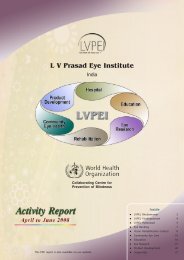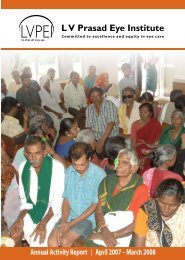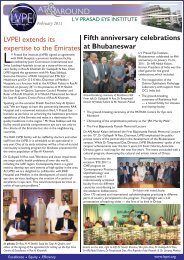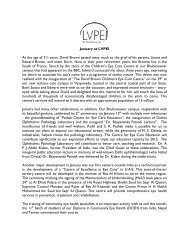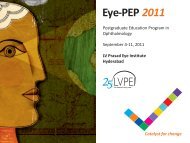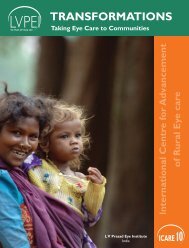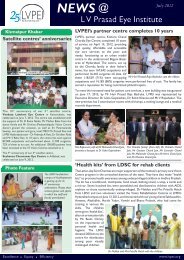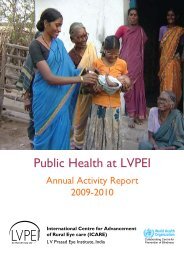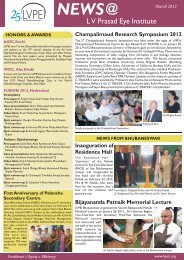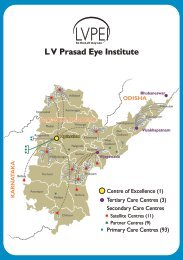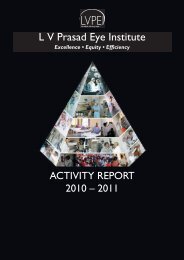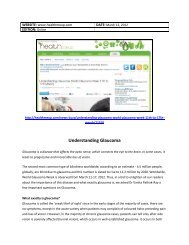Glimpses 2009-2010.pdf - LV Prasad Eye Institute
Glimpses 2009-2010.pdf - LV Prasad Eye Institute
Glimpses 2009-2010.pdf - LV Prasad Eye Institute
Create successful ePaper yourself
Turn your PDF publications into a flip-book with our unique Google optimized e-Paper software.
Step by step progress in<br />
stem cell research<br />
When I joined this <strong>Institute</strong> in 1998<br />
as head of the pathology service, the<br />
diagnostic workload did not fill my<br />
working hours. So I began looking at<br />
some interesting questions in fungal<br />
keratitis and retinoblastoma, where I<br />
wanted to understand how malignant cells<br />
differentiate into terminally differentiated<br />
benign cells, as they do in neuroblastoma,<br />
another childhood tumor. I initiated<br />
some cell culture work to evaluate my<br />
hypothesis and had a reasonable amount of success. Success raises hopes and this is what happened in<br />
my case, too. One morning when I was discussing my results with my colleague Virender S Sangwan,<br />
he challenged me to put this knowledge to better use by applying it to help treat limbal stem cell<br />
deficiency. An effort that started as an earnest attempt to help a friend and do need-based research,<br />
led to success and recognition that we never imagined! However with increasing knowledge of adult<br />
stem cells, and increasing clinical diagnostic work in the lab, especially of retinoblastoma, my interest in<br />
retinoblastoma was kindled again. Stem cells... differentiation... resistance to chemotherapy... all started<br />
making more sense to me. With the excitement of solving a jigsaw puzzle I initiated work on cancer<br />
stem cells in retinoblastoma. And yes! I found evidence of cancer stem cells in retinoblastoma. Once<br />
again we had hit upon something exciting that has implications beyond the academic, with the promise<br />
of making a big difference to children suffering from retinoblastoma.<br />
Geeta K Vemugani<br />
Sudhakar and Sreekanth Ravi Stem Cell Biology Laboratory<br />
Ophthalmic Pathology Laboratory<br />
Cell biology research: induced pluripotency<br />
<strong>LV</strong>PEI’s stem cell work has benefited over 700 patients over the past 8 years with an overall success<br />
rate of 50-60% but there are other ocular disorders that could conceivably benefit from regenerative<br />
medicine—such as the retina. The adult retina has no stem cells and therefore it becomes important<br />
to identify a suitable cell type that can be used in therapy. While embryonic stem cells are known to<br />
be a source of “pluripotent” cells (which<br />
can differentiate into many different cell<br />
types), there are many ethical issues that<br />
arise with the use of embryonic tissues<br />
in research. We have focused on trying<br />
to generate pluripotent cells from adult<br />
sources and, more specifically, directly<br />
from the patient’s cells.<br />
Mature somatic cells can be<br />
reprogrammed to a pluripotent state by<br />
different methods like transferring their<br />
nucleus into enucleated oocytes (the<br />
story behind the making of Dolly, the<br />
first cloned sheep). Work in Japan and<br />
Excellence Equity Efficiency Page<br />
34<br />
F_Inside_Pgs.indd 34<br />
9/2/2010 12:32:40 PM



